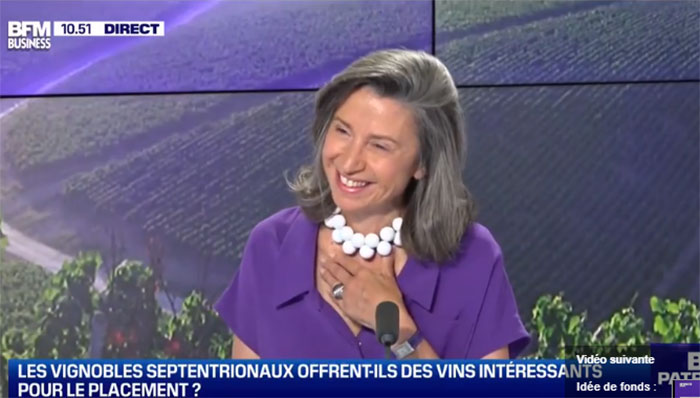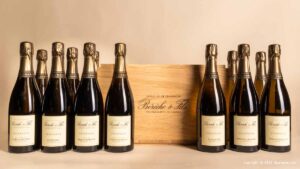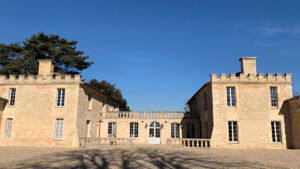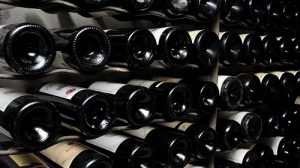
Angélique de Lencquesaing spoke to Cédric Decoeur during an interview on the French news channel BFM, discussing wines from northern regions. In the context of global warming, these wines offer an interesting way forward for wine collectors.
Cédric Decoeur: When hot weather strikes, we go on the hunt of freshness and that includes wine. So how about we take a tour of some northern wine regions? Together with you, Angélique de Lencquesaing, we will see if these wines offer investment opportunities.
A. de L: Climate change, which affects the vines, has caused wine lovers to adjust their choices, not only in terms of the colour of the wine they choose but also their region of choice.
What regions are we talking about here?
When looking at a map of France, if you were to draw a horizontal line across the country where the city if Orléans is, you’ll find a few vines growing in the west of the country, in Brittany, Normandy and even the Paris region but in terms of investment opportunities, we have to look towards the east,
We will find a number of fascinating regions there, starting with Champagne and Chablis.
Champagne, as we’ve discussed before, is a fascinating region in terms of investment. Chablis has also been around for a long time but is it a region to consider when looking at investment possibilities?
Chablis is one of the most famous French regions in the whole world. It has a significant size too (nearly 6000 ha) which amounts to 19% of the total production of wines from Burgundy. The Chablis grand crus only cover 1% of the region’s surface area and one climate stands out in particular, Les Clos. Among the 365 producers who work in this AOC, it is quite surprising that two winemakers are head and shoulders above the rest especially in the auction market. They are Raveneau et Dauvissat. When looking at Domaine Raveneau’s wines, the price estimate of its Clos Premier Cru from the 2010 vintage has multiplied by 8 to surpass €1800. Domaine Dauvissat’s wines are also very popular, and their price estimates have increased (€551 for Les Clos 2020).
At such prices, do these wines still have the potential for growth?
The recent vintages are already at a higher level than before; appreciation in value is likely to happen in the longer term. It’s best to look at producers who are not necessarily at the centre of the radar and are nevertheless enthralling. Droin, William Fèvre, Long Depaquit, Louis Michel, Château de Béru and Pattes Loup, the list goes on. An interesting alternative is to look in the neighbouring region of Irancy and the Pinot Noirs produced by Domaine Dauvissat as well as Pattes-Loup (Pinot Black), Goisot and Colinot.
We’re going to leave the world of fresh whites for a moment to talk about red wines. You mentioned Pinot Noir which is so popular in the Côte de Nuits and Côte de Beaune. Do these more northerly regions offer a good alternative for a lower price?
Yes, that’s right. Pinot Noir wines from Irancy, Côtes d’Auxerre, and further east, Alsace are attracting the attention of wine enthusiasts. This is one of the ways that climate change has helped winemakers. Grapes can now ripen perfectly in these places and deliver delicious wines.
In Alsace? That’s known for being a white wine region, isn’t it?
Yes, and we will come back to that. But for several years now, winemakers who have been producing small amounts of Pinot Noirs have seen demand for them grow. Domaine Albert Mann is a leading producer here and has been growing Pinot on terroirs that are only classified grand cru for white vines. These red wines have names such as Grand H (named after the Hengst terroir), Grand P (named after the Pfersigberg terroir)… When looking for Pinot Noirs, we can recommend those from Zusslin, Deiss and Weinbach, whose S wine is still a secret treasure.
These terroirs are not too cold given the continental climate that they are known for? Especially if we add global warming…
The altitude is one of their secrets. The grand crus are located on slopes with perfect drainage and sun exposure. This results in fascinating wines marked by centuries of viticultural history. The variety and complexity of the terroirs (volcanic, limestone, sandy, etc.), and the lower quality of a significant amount of the production requires skill. The greatest winemakers tend to export most of their top wines and wine lovers in the know have uncovered the mysteries of these very fine wines.
And as they are not seen at auction very often, they don’t keep as well?
Alsace wines only represent a little more than 1% at auction but it’s not their longevity that is the reason for this, quite the contrary. The fantastic local specialities of Vendanges Tardives (wines made from late harvest grapes) and Sélections de Grains Nobles (wines made from grapes affected by noble rot) are particularly popular. A half bottle of 2002 Grand Cru Furstentum, a Quintessence de Grains Nobles Cuvée d’Or from Domaine Weinbach sold at auction for €347 in the first half of the year.
Sweet wines are then highly sought-after? Or is it best to go for dry ones?
The ageing abilities of sweet wines know no bounds. But among the dry white wines, we can also find an icon, the Riesling Clos Sainte-Hune from Trimbach. It’s a wine that can be aged and mature vintages from 2001 and 2002 go for between €250 and €280 at auction. The region’s continental climate is an ideal place to use more environmentally friendly viticultural techniques (Albert Boxler is a great example of this) as well as organic and biodynamic practices. Deiss, Zind-Humbrecht and Bott-Geyl are also good examples.
And if we cross over the border to Germany, its wines also offer investment opportunities? Do you see them at auction?
Absolutely, Germany is known for having a famous auction every year in Trier. It’s probably one of the largest Riesling auctions in the world.
On iDealwine, these wines are rare but still feature in our auctions. It helps to know a little about the language of Goethe to understand what is written on the labels… Or you can take a look at the German version of our website. 😊
The wines are classed according to the maturity of the grapes when they are harvested unlike in France where they are classified according to their residual sugar. Kabinett denotes wines that are dry or off-dry with a lower alcohol content (but just be aware that these wines don’t use the same definition of dry as in France). Spätlese and Auslese are similar to Vendanges Tardives and Sélection de Grains Nobles from Alsace but are less intense. Beerenausle and Trockenbeerenauslese are equivalent to Vendanges Tardives and Sélection de Grains Nobles. And the ultimate category is Eiswein, made from frozen grapes and produced in tiny quantities.
Could you please give us a few names to look out for?
Among the German wineries known for their exquisite white wines, there are Egon Müller in the Mosel close to the Luxembourg border, as well as Markus Molitor, Joh. Jos Prum and Dr. Loosen. Willi Schaefer is also charming. An auction icon is Weingut Keller which is located in Rhein-Hessen. A bottle of its highly sought-after Riesling G Max from 2005 sold for €1,984 at auction. All these wines deliver unbelievable freshness, remarkable depth and are simply enthralling.
See all Chablis wines for sale
Browse Alsace wines
Shop all German wines



